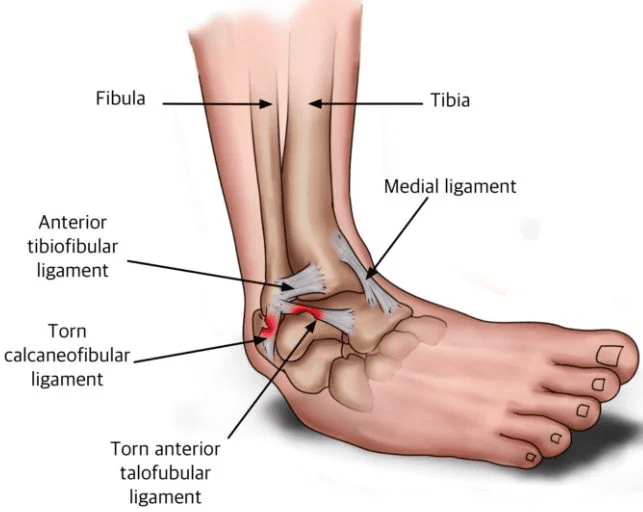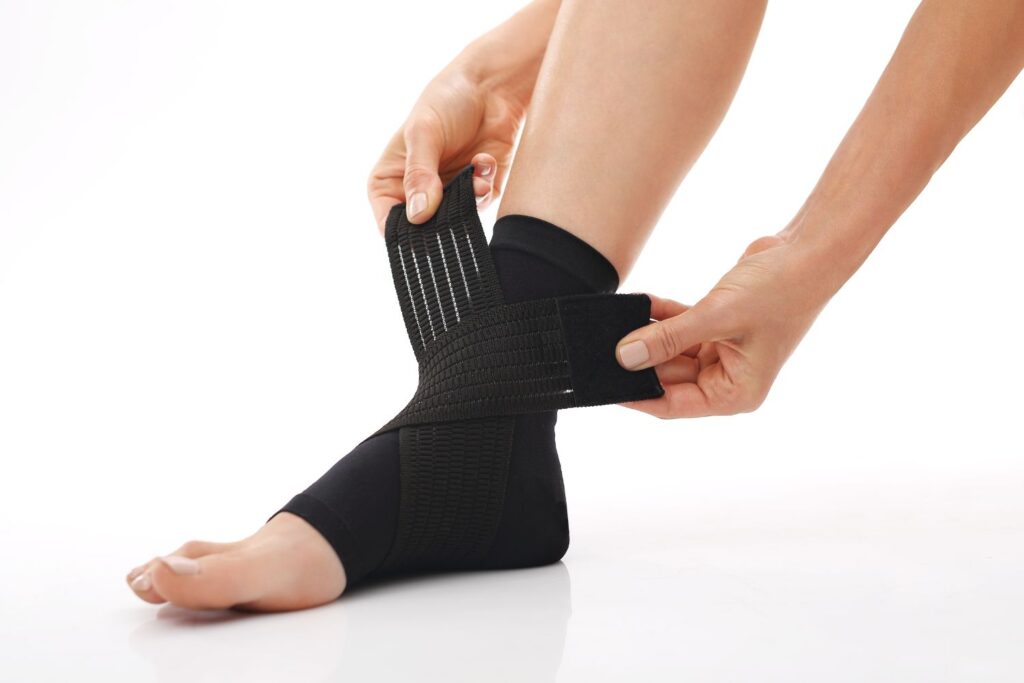Every Saturday, you can bet that some “lucky” netballers will leave the court with twisted, turned, or sprained ankles. But why do these injuries happen, and more importantly, how can they be prevented?
Verity delves into the mechanics of ankle injuries in netball, the pros and cons of taping versus bracing, and offers practical advice to keep players of all ages safe and performing at their best. Whether you’re a young enthusiast or a seasoned adult player, discover the best strategies to support your ankles on the court!
Why Do Ankle Injuries Happen in Netball?
Netball is a dynamic sport that requires players to make sudden stops, dodges, and quick turns. These high-intensity movements are essential for outmaneuvering opponents, but they also add additional load to our lateral ankle ligaments.
If we overdo it and go into too much inversion (rolling the ankle in), we can sprain these ligaments. Unfortunately, once damaged, these ligaments only regain about 80% of their original strength during the healing process, leaving them weaker and more susceptible to future injuries.

What Can We Do to Prevent Future Ankle Injuries?
Beyond a robust rehabilitation program to strengthen surrounding muscles and enhance proprioception, taping or bracing the ankle is the most effective method of providing stability and preventing re-injury on the court.
Why Do Professionals Prefer Taping?
Watch elite netball teams such as the Australian Diamonds or Suncorp Super Netball League players, and you’ll notice that many of them choose to tape their ankles. These athletes are fortunate to have access to trained professionals who can apply tape tailored to their specific needs, providing optimal support without hindering their performance.


At the professional level, players strive to gain every possible advantage. There has been speculation and anecdotal evidence suggesting that bracing might impact function and performance outcomes, leading many athletes to choose taping options. However, a meta-analysis of seven studies indicated that ankle bracing does not significantly affect vertical jump height, running speed, agility, or broad jump (Bot & Van Mechelen, 1999). This suggests that concerns regarding bracing impairing performance may be exaggerated.
Why Choose Bracing
Bracing is a fantastic alternative for amateur players who do not have access to trained professionals. Like taping, bracing effectively limits the amount of inversion at the foot, providing essential support.
A meta-analysis of treatment strategies for acute ankle sprains and chronic ankle instability (CAI) revealed that wearing a brace significantly decreases the incidence of ankle sprains. It was concluded that wearing a brace upon returning to the sport can significantly reduce your risk of re-injury after an ankle injury (Doherty, Bleakley, Delahunt & Holden, 2016).

Bracing also has an edge over taping in terms of maintaining mechanical strength. A study conducted in Cologne, Germany, involving 17 professional male soccer players, demonstrated that after 45 minutes of activity, a taped ankle’s range of motion increased from 7 degrees of inversion to 12.6 degrees (Best, Mauch, Böhle, Huth & Brüggemann, 2014). This suggests taping loses its mechanical effectiveness over time, whereas bracing remains consistent.
Braces are incredibly user-friendly. They are easy to put on and adjust, making mid-game tweaks more manageable than re-taping an ankle. Furthermore, braces are cost-effective in the long run, machine washable, and skin-friendly, providing additional practical benefits.
Practical Tips for Taping and Bracing
To make sure you’re getting the best support, here are some tips for taping and bracing your ankle:
Taping:
- Preparation: Always ensure you clean and dry the skin. Apply an adhesive spray or under-wrap to protect the skin.
- Locking Strips: Use additional strips to lock everything in place, ensuring the tape is snug, but not too tight.
Bracing:
- Fitting: Ensure the brace fits well. It should be snug but not restrictive.
- Adjustment: If the brace feels loose during play, adjust the straps to maintain optimal support.
- Maintenance: Regularly wash and inspect the brace for wear and tear, replacing it as needed to ensure consistent support.
What Next?
If you’re reading this and think that your unreliable ankle might need extra support on the court, I recommend consulting your allied health professional about a comprehensive rehabilitation program and getting fitted for a brace. Remember, proper support can make a significant difference in preventing injuries and maintaining your performance, on and off the court.
Dr Verity Boyd
Osteopath and Group Exercise Rehab Instructor

References
- Best, R., Mauch, F., Böhle, C., Huth, J., & Brüggemann, P. (2014). Residual Mechanical Effectiveness of External Ankle Tape Before and After Competitive Professional Soccer Performance. Clinical Journal Of Sport Medicine, 24(1), 51-57. doi: 10.1097/jsm.0b013e31829ddc74
- Bot, S., & Van Mechelen, W. (1999). The Effect of Ankle Bracing on Athletic Performance. Sports Medicine, 27(3), 171-178. doi: 10.2165/00007256-199927030-00003
- Doherty, C., Bleakley, C., Delahunt, E., & Holden, S. (2016). Treatment and prevention of acute and recurrent ankle sprain: an overview of systematic reviews with meta-analysis. British Journal Of Sports Medicine, 51(2), 113-125. doi: 10.1136/bjsports-2016-096178

